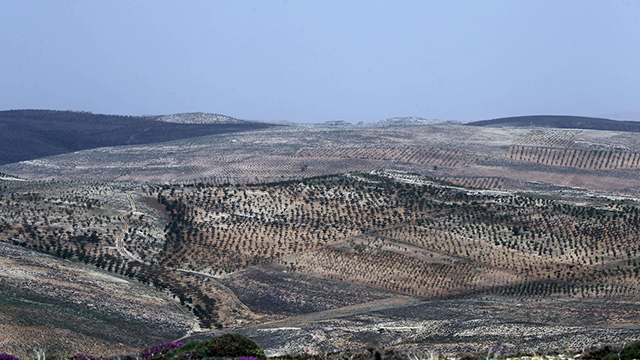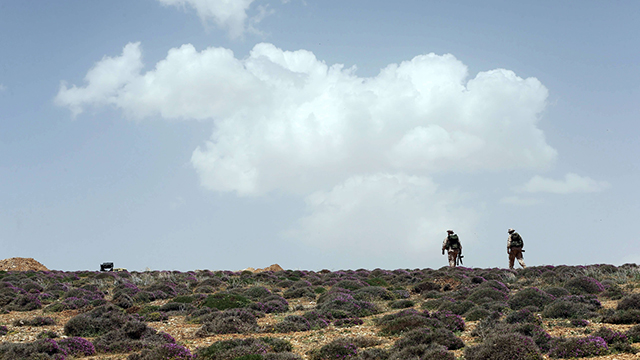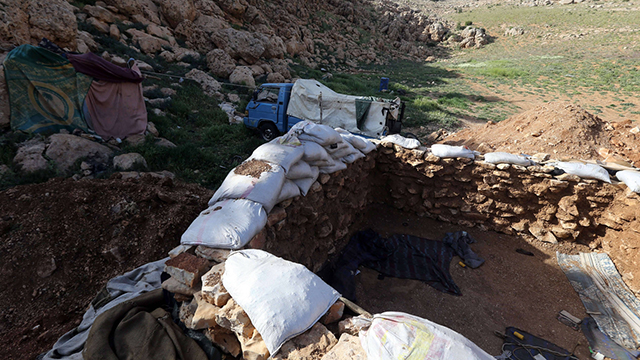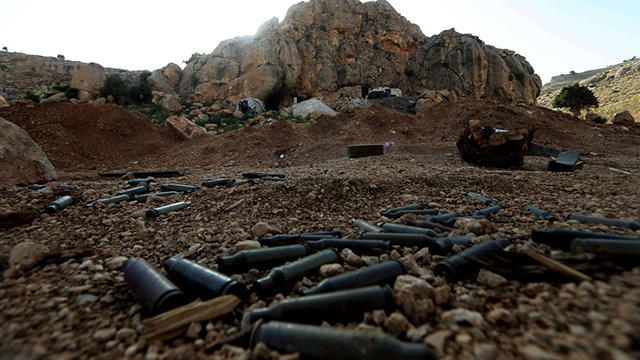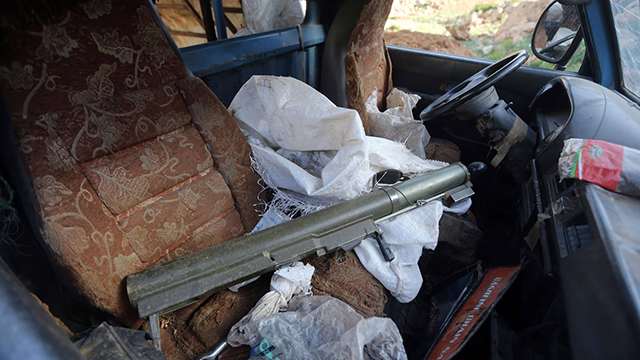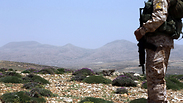
Eyewitness report: On tour with Hezbollah
After imposing strict restrictions on what they could film and photograph, Lebanese terror group takes foreign journalists on an unusual trip to its positions on Syrian border.
"I just don't like doing poses," he sighed as the photographers asked him to move his Kalashnikov so it would appear in their shots, which could not include his face.
The interaction was part of an unusual media tour organized by the powerful Lebanese Shiite group of their positions in the Qalamun region on the porous Syria-Lebanon border.
Hezbollah usually prefers limited interaction with the media – its spokespeople seem to be available largely to say "no comment" – but in recent weeks it has begun something of a charm offensive.
A rare PR campaign
It has taken several groups of local and foreign media to Qalamun in a rare PR campaign that seems intended to build support for its role as a key force multiplier for Syria's President Bashar al-Assad.
The junket was an unusual opportunity to spend time up close with the group, which is listed as a "terrorist" organization by Washington, but says it is fighting the same jihadists being targeted by a US-led coalition in Syria and Iraq.
In keeping with Hezbollah's reputation for organization, the trip AFP joined was meticulously planned and carefully orchestrated.
We began with the sort of briefing familiar to anyone who has covered military affairs – complete with a commander using a laser pointer to explain the mountainous terrain of Qalamun and the importance of capturing its high ground.
Then we headed off in a convoy of SUVs to the eastern town of Baalbek – famed for its beautiful Roman ruins – where we veered into the no-man's land of Qalamun.
The last few houses in Baalbek disappeared behind us as our cars bounced along the semblance of a road carved into the valley by bulldozers. As we moved around the region, there was nothing to indicate where Lebanon ended and Syria began, no border posts or army presence anywhere to be seen.
No faces, no voices, no military vehicles
We were issued strict instructions about what we could film, photograph and record. No photos of faces, no recordings of voices, no pictures of military vehicles or anything that would identify where we were.
The rules proved frustrating for the photographers and video journalists with us, who at times looked as though they were on safari – snapping excitedly into action when our minders pointed them towards some rare fighters who they were allowed to film or photograph.
We couldn't ask about future operations, or anything that veered into what the Hezbollah officials with us considered "political," including the striking absence of the Lebanese army in the fight to secure a portion of the country's border.
Prepared remarks
At each stop, among them Hezbollah positions and bunkers captured from jihadists and rebels, a designated commander gave prepared remarks.
Stern behind his sunglasses, he paused briefly with barely concealed irritation when interrupted with questions during his presentation, picking up where he left off without answering until his remarks were complete.
Many of the Hezbollah fighters who accompanied us – driving from point to point in pick-up trucks, some painted in desert camouflage – were reluctant to talk. They watched us carefully, dressed mostly in digital desert camouflage fatigues, some smoking, as though waiting to see if we'd try to trick them into saying something they shouldn't.
At one point, one fighter stripped off his floppy hat and heavy-duty boots to pray on his jacket laid out on the ground. "Don't even think about photographing me," he admonished the photographers watching him nearby.
Tuna and stuffed grape leaves
When one member of the group wandered off into the hillside to relieve himself without notifying our minders, a fighter fired a warning shot into the air to bring him running out into the open.
But others were less suspicious, engaging cautiously with journalists about the fight and even cracking jokes.
Half-way through the tour, we broke for lunch. "Don't let them say we didn't feed you!" one fighter laughed as he handed out tins of tuna and stuffed grape leaves to the group.
Afterwards, we continued on the tour, exploring a bunker where a minder carefully positioned the remains of an anti-tank missile so the visitors wouldn't miss it.
Inside, items including medicine and clothing were strewn haphazardly, except for a pristine label bearing the name of a Syrian rebel group that was affixed to a sandbag.
At the end of the tour, we gathered for the ride back to Baalbek and one of the Hezbollah media officials came over. A friendly type, he’d confided earlier that his recent laser surgery was "the best decision of my life" as he applied his eyedrops. Now he wanted to say goodbye, and had a request:
"Let's take a quick selfie," he said, grinning as he leaned into our car and snapped a stealth photo with his iPhone.
Sara Hussein is an AFP reporter for Lebanon and Syria, based in Beirut.











